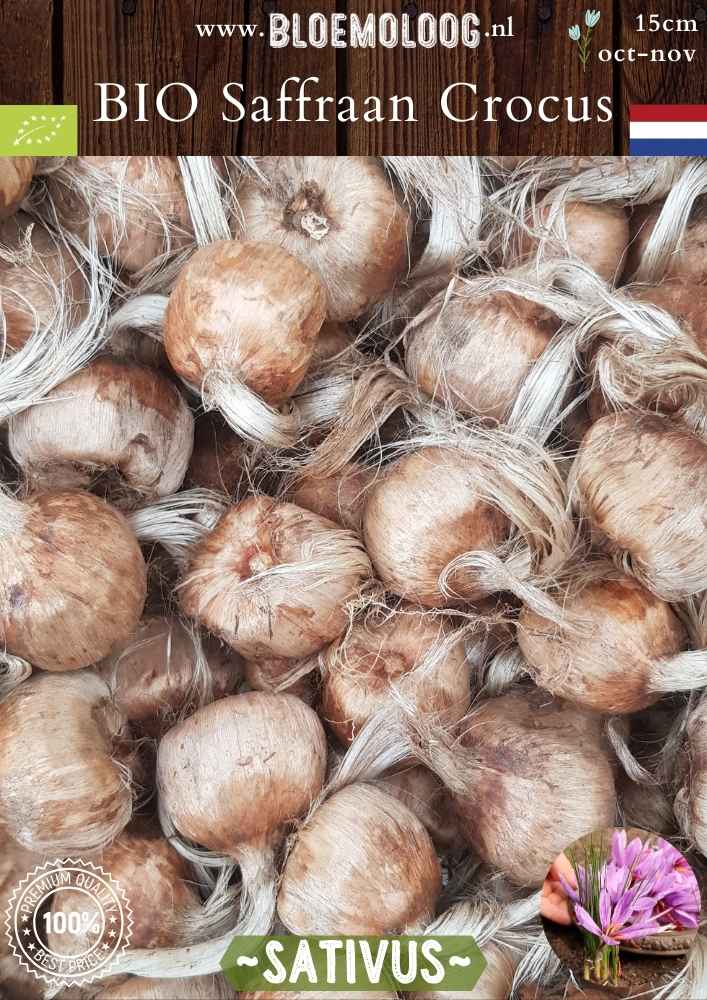Organic Saffron Crocus
The Crocus 'Sativus' is the one true saffron crocus and is a stunning sight in late autumn. It blooms around late October to early November when the bulb is replanted, and a bit earlier if the bulbs have been in the ground for a year. The flower itself grows to about 15 centimeters tall and blooms in a light purple color with yellow stamens, which serve as an excellent food source for pollinators so late in the year. The saffron consists of the red stigmas. The narrow leaves are about the same height as the flower during blooming but continue growing until April before dying back naturally.
Bloemoloog offers high-quality bulbs measuring 10 to 11 centimeters in size, sometimes producing two flowers per bulb. And yes, they truly produce saffron, perfect for cooking! The large bulbs are so strong they can even bloom indoors on a dish without soil or water, solely from warmth. However, make sure to plant them in the garden right after blooming so they can recharge.
Do not confuse the saffron crocus with other autumn-blooming crocuses like the Crocus 'Speciosus' or the toxic Colchicum 'Autumnale', which also blooms in the fall!
Culinary Use
Adding saffron to dishes not only gives a beautiful golden color but also adds a unique flavor. Once the flower opens, the red threads (stigmas), preferably early in the morning, can be harvested using tweezers. These can be dried in the oven at 50°C for about fifteen minutes. Then store the saffron in an airtight jar for a month to allow the aromas to fully develop. After that, it’s ready to be used in the kitchen to add color and flavor to dishes such as paella, cake, or soup!
How, Where and When to Plant Saffron Crocus Bulbs?
Saffron crocus bulbs are planted from September to October. Planting depth should be 2 to 3 times the bulb’s height, and spacing should be 2 to 3 times the bulb’s width. Plant in groups for a nice effect. The best spot is in full sun. Make sure it receives at least 6 hours of sunlight per day to build energy for the following year.
Plant it in nutrient-rich, well-draining soil. Loam is acceptable, but loose sandy soil is preferred. The soil must not be too heavy, as proper drainage is essential to prevent bulb rot.
Caring for Saffron Crocus
The bulbs can remain in the ground for multiple years of blooming, as long as no other plants grow around them. For the best results, dig up the bulbs in June or July and store them in a warm spot in the shed. Replant the bulbs in September. Apply organic fertilizer yearly for optimal growth.
For organic potting soil, plant nutrition or other soil improvers, we recommend Bio-Kultura!
Propagating Saffron Crocus
The Crocus 'Sativus' does not propagate via seeds, as it is a sterile triploid hybrid. During blooming, new bulbs grow on top of the old ones. These can be separated early in summer and replanted in different spots in August or September.
Medicinal Use
Saffron is used for its mood-enhancing properties in the treatment of depression, anxiety disorders, and various other conditions such as obesity, Alzheimer’s disease, and certain eye conditions. These medicinal benefits are due to the presence of safranal and crocin, substances naturally found in saffron. Safranal is an aromatic compound responsible for saffron’s characteristic scent and has proven antidepressant and calming properties. Crocin, on the other hand, is a carotenoid pigment responsible for saffron’s intense color and has antioxidant and anti-inflammatory effects.
However, it is important to note that while saffron has promising properties, it is not a substitute for professional medical treatment.
Always consult a doctor before using saffron or any other herbal or dietary supplement as part of a treatment plan.
Origin of the Saffron Crocus
The Crocus 'Sativus' is a hybrid that does not occur in the wild. Thousands of years ago, likely during the Bronze Age, it was developed through cultivation on the island of Crete and has been cultivated ever since.
The history of the saffron crocus is rich and fascinating. The cultivation of saffron dates back at least 3,500 years and has played a prominent role in various ancient civilizations.
Origin of the Name 'Saffron'
Interestingly, the Arabic word "asfar" means "yellow", while "za'ferân" refers to "dyed with yellow". This indicates that saffron, like turmeric, has been used for centuries in Eastern cultures as both a dye and flavoring agent.
World’s Most Expensive Spice
Today, saffron remains one of the most expensive spices in the world, mainly due to its labor-intensive harvest process. It still requires handpicking the delicate stigmas, resulting in a limited and costly yield.
Organic Saffron Crocus Order Information
✅ Skal certified: 109459
📦 Packed per 7 bulbs or choose stacking discount!
💰 Stacking discount: D
📆 Available to order from June '25!
📬 Shipping €5.95 - Free shipping for orders over €50.
Specifications
| Blooming period: |
October – November |
| Planting time: |
From September |
| Planting depth: |
15 cm deep |
| Plant spacing: |
10 cm apart |
| Height: |
15 cm tall |
| Flower diameter: |
7 cm wide |
| Sun exposure: |
Full sun |
| Soil: |
Loam, sandy soil – Lightly alkaline/neutral |
| Winter hardiness: |
Hardy |
| Propagation: |
By bulb (not by seed – sterile triploid taxon) |
| Origin: |
Hybrid |
| Family: |
Iridaceae (Iris family) |
| Color: |
Lavender with purple veins |
| Bee-friendly: |
Yes |
| Fragrant: |
Yes (mildly) |
| Bulb size: |
10/11 |
Other Crocus Varieties:
- Organic Crocus chrysanthus 'Romance'
- Organic Crocus tommasinianus 'Ruby Giant'
- Organic Crocus vernus 'Jeanne d'Arc'
- Organic Crocus vernus 'King of the Striped'

NL-BIO-01















